|
| |
Back to private
aircraft
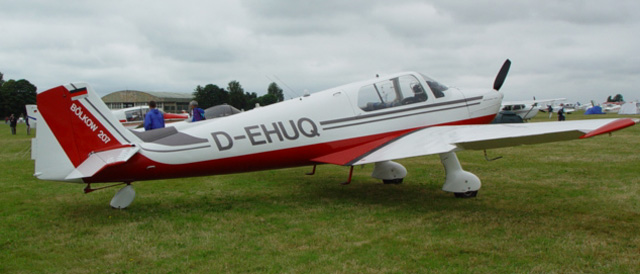 |
The Bolkow 207 was an upgraded version of the
Klemm 107, designed as a light two seater by the well-known German
designer. When Klemm ceased functioning after the war, the design
was taken over by Bolkow. It embodies much of what is best in German
engineering. It it sound, robust, functional and the attention to
detail in the fabrication is superb. The Bo207 is a four seater,
powered by a 180hp Lycoming O-360 engine, which gives it a cruising
speed of 140mph and range of 775 miles. the long (35 feet 6 inches
span) wing gives it a superb rate of climb. The Bo 207 first
flew in October 1960.
Photograph by Ivy at Kemble in July 2005. |
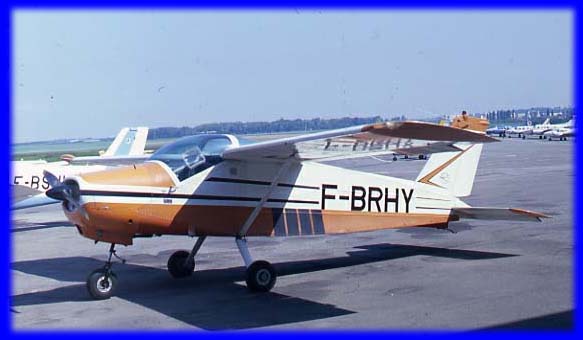 |
The Bolkow 208 Junior was designed by Swedish
designer Bjorn Andreasson, and first flew (as his homebuilt
aircraft) in October 1958. Bolkow built about 200 under license
during the 1960s. The peculiar wing position (reminiscent of the
Nipper or the Nord NC854) is actually very good for visibility,
because the pilot can see above or below with equal ease. It is
powered by a 100hp Rolls-Royce Continental engine, giving it a
cruising speed of 125mph and range of 620 miles. It is a compact two
seater, 19 feet long, with a wing span of 26 feet 4 inches. Malmo
Aviation in Sweden later developed the design into a series of
military trainers and light attack aircraft (see MFI-15).
This one was at Toussus in June 1979. |
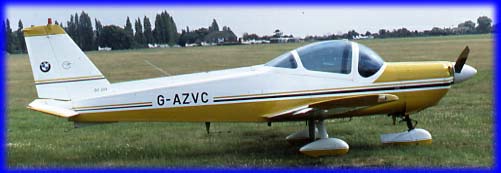 |
The Bolkow 209 Monsun first flew in December
1967. It is a two seater with basic aerobatic capability and
beautiful control harmonisation. It is powered by a Lycoming engine
of either 150 or 160hp., giving it a cruising speed around 150mph
and range of 750 miles. It is 21 feet 8 inches ling, with a wing
span of 27 feet 7 inches and gross weight of 1,800lb. After Bolkow
were absorbed into the giant MBB (Messerschmit-Bolkow-Blohm)
combine, forerunner of Deutsche Aerospace, the company rather lost
interest in this end of the market and, sadly, production petered
out. This one was at Denham in the
1970s, exact date uncertain. |
|
|
The Bucker Bu131 Jungmann was the standard
German training aircraft during the 1930s and into the early 40s -
broadly the German equivalent of the Tiger Moth. I was designed by
Swedish designer Anders Andersson and built by Bucker in Germany. It
first flew in April 1934. Several thousand were built,
including over 500 by CASA in Spain as the E.3. It is powered by a
Hirth inline engine of either 80 or 105hp, which gives it a top
speed of 115mph and range of 400 miles. It is a compact aircraft, 21
feet 8 inches long, with a wing span of 24 feet 3 inches. Gross
weight is 1,500lb. The top picture shows
a former Spanish air force CASA 1.131 at Sandown in February 2006.
The lower picture was taken at Kemble in July 2005. |
 |
The Bucker Bu133 Jungmeister was a single
seat advanced aerobatic trainer derived from the Jungmann, which
first flew in 1935. It is smaller (19 feet 9 inches long, 21 feet 8
inches wing span) and lighter (1,290lb) than its two seat forebear.
Its 160hp Siemens SH14 radial engine gives it a top speed of 135mph
but, more importantly, phenomenal aerobatic capability.
This Jungmeister (with David's father's cousin
talking to the pilot) was pictured about to disturb the sheep at
Headcorn in July 1977. |
 |
The Extra 230 / 260 series was developed by
German designer Walter Extra in the early 1980s as one of a new
breed of very light weight, high performance aerobatic aircraft. The
aim was to replace the older generation of Zlins and Pitts Specials
which had hitherto dominated the aerobatic scene; competitors
include the CAP range. It amply fulfils the design specification. it
is powered by a 200hp Lycoming AEIO-360 engine. Note the structure
trailing from the wingtip, which is a sight gauge to help pilots
line up for precise vertical and 45 degree manoeuvres.
This picture is of an Extra 260, date and place
uncertain. |
 |
The Extra EA300 first flew in May 1988, and
was an improved version of the earlier 230 / 260 series. The 300 has
a 300hp Lycoming AEIO-540 engine and is larger (23 feet 4 inches
long, with a wing span of 26 feet 3 inches). It is capable of even
better performance than its predecessor. Over 170 have been built,
making it one of the leading specialist aerobatic designs. Unlike
the 230/260, the 300 has a two seat version as well as the single
seat 300S. This picture is of the
Jordanian national aerobatic team, the Falcons, at Fairford in July
2007. |
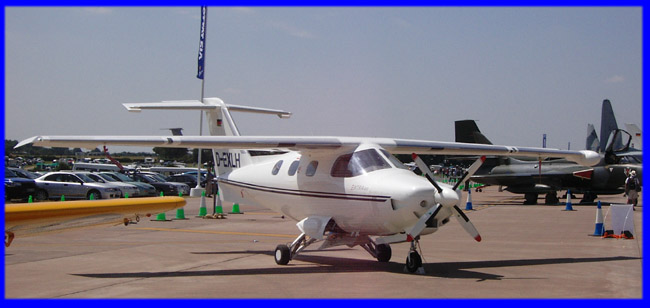 |
The Extra EA400 is Extra's first foray
outside the specialist aerobatic arena. It is a six seat luxury high
speed touring aircraft, powered by a 350hp Continental engine,
giving it a cruising speed of 230mph and range of over 1,100 miles.
It is all fibreglass and pressurised for flight at high altitude, as
well as having a modern `glass' cockpit. It is 31 feet long, with a
wing span of 38 feet. About 25 have been built so far (as of early
2006). This one was at Fairford,
July 2005. |
 |
The Grob 109 is a powered glider,
designed by Dr Burkhardt Grob. His company has specialised for many
years in gliders, and therefore acquired a wealth of expertise in
light weight strong composite construction. This is put to excellent
use in the 109, which is powered by a 90hp engine of Grob's own
design. its wing span - a massive 57 feet - gives away its glider
parentage. It is also 26 feet 7 inches long. It has become a very
popular machine in its class, with an excellent safety record; among
others, it is used by the Air Training Corps to give cadets air
experience flights. The G109 first flew in March 1980.
This one was at Enstone in Summer 2005. |
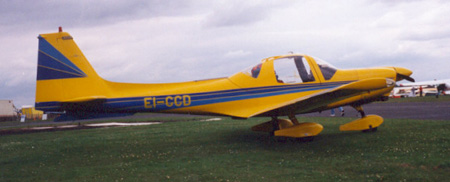 |
The Grob 115 two seater is similarly made of
glass-fibre reinforced plastic, and first flew in November 1985. It
can be powered by either a 115hp or 160hp Lycoming engine, which
give it a top speed of either 150 or 190mph respectively and a range
of 620 or 870 miles. Gross weight is just under 2,000lb (160hp
version). It is a fairly substantial machine for a two seater, being
24 feet 10 niches long and having a wing span of 32 feet 10 inches.
It is still in production at the time of writing (March 2006), with
over 200 having been made to date. (Cranfield,
July 1998) |
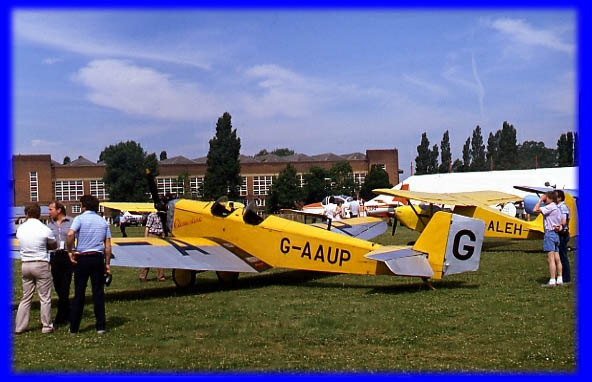 |
The Klemm KL25 is a very stable, gentle two
seat touring aircraft dating from 1927. It is powered by a 40hp
Salmson radial engine, which gives it a cruising speed of 85mph and
range of 600 miles. Gross weight is 1,350lb. It has a wide span, 42
feet 7 inches, and is 24 feet 7 inches long. Its common ancestry
with the British Aircraft Swallow is very apparent.
Few remain today; this one, imported to the UK
in 1930, visited Cranfield in July 1984. |
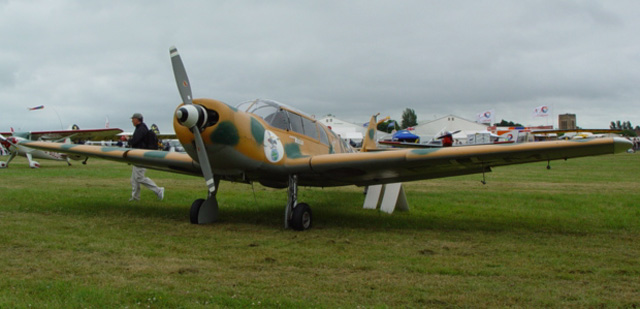 |
The Messerschmitt Bf108 Taifun was one of the
earliest designs by Bavarian designer Willy Messerschmitt, of 109
fame. (The Bf designation stands for Bayerische Flugzeugwerke). it
first flew in June 1934, and must have looked very advanced for that
time. It is a four seater with stunning performance for its day,
thanks to a 240hp Argus V8 engine: top speed was 215mph, range 870
miles and gross weight 2,980lb. 500 were made by Messerschmitt
before they had to devote all their space to 109 production, and the
108 was licensed to Nord Aviation in France. Nord produced a further
285 as the 1001 Pingouin, many being built after the war. In the
1930s, one was even used as a personal transport by the US military
attache in Europe, and received the US Army designation XC-44!
This one was at Kemble in July 2005. |

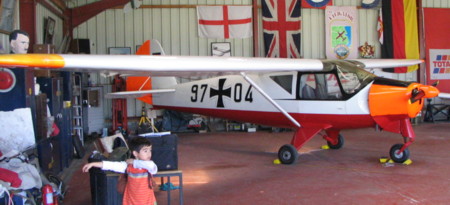 |
The Putzer Elster is a simple two seat
touring aircraft developed by Alfons Putzer in the late 1950s. It
was intended as a competitor to the Cessna 150 but its wooden
construction prevented it being cost competitive with the metal
Cessna. It is powered by a 95hp Continental C90 engine, which gives
it a cruising speed of 95mph and range of 280miles. Gross weight is
about 1,550lb. Stalling speed is only 45mph, making it a very safe
aircraft to land; this is enabled by its wide (glider derived) 43
foot 4 inch wing.
This is one of a small number of Elsters to be
registered in the UK. Top: at Cranfield, date uncertain but probably
mid 1980s. Bottom: Breighton,June 2007. The very wide wing is
clearly visible. |
 |
The RS180 Sportsman was designed in the late
1970s by Sportavia-Putzer GmbH, and briefly produced in
extremely small numbers by RFB. This is, I believe, the only one to
be imported to the UK. It is a four seater with exceptional
visibility, powered by a 180hp Lycoming O-360 engine. Gross weight
is 2,420lb. I vaguely recall several years ago being told that it
was in fact a much modified Fournier RF6, and one can see the
resemblance; but I am not sure how accurate that information is.
It was pictured at Cranfield in July 1983. |
 |
The Ruschmeyer R90 is a sleek modern four
seat touring aircraft which first flew in August 1988. Its 230hp
Lycoming IO-540 engine gives it a cruising speed slightly less than
its appearance would indicate, at 160 mph, and a range of 960 miles.
Gross weight is 2,975lb. It is 26 feet long, with a wing span of 31
feet 2 inches. Unfortunately Ruschmeyer hit financial difficulties
and production ceased after only 30 had been built.
This one was at Toussus in Autumn 2005. |
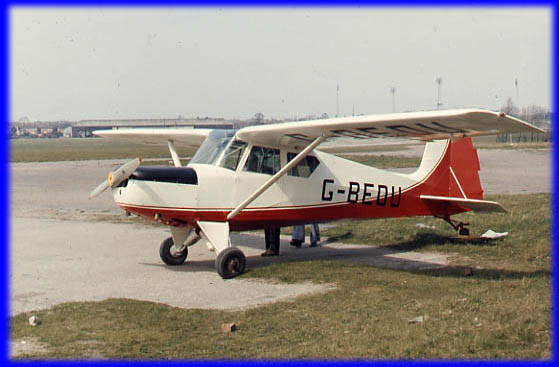 |
The Scheibe company was founded by Dr Egon
Scheibe in the early 1950s. It is mainly a glider maker, but in the
late 1950s they produced the lovely little SF23 Sperling (Sparrow)
two seat light aircraft. Powered by a choice of 95 to 115hp engines,
the Sperling manages 100mph cruising speed and has a range of 370
miles. It is 20 feet 4 inches long, with a wing span of 32 feet 4
inches, and gross weight of 1,600lb.
This one was at Doncaster (the delightful old
airfield near the football ground, now sadly a housing estate) in
April 1977. |
 |
The Scheibe SF25 Falke became
one of the standard powered gliders in the 1960s and 70s. It is a
two seater, powered (just) by a 45hp Stark Stamo engine. It
has a 50 foot wing span and is 24 feet 10 inches long.
This one was at Bicester in August 1975 |
 |
Schleicher is another experienced glider
maker, with famous 1950s designs such as the K-6 and K-7 Rhonadler.
The ASK-16 is a powered version, with a Limbach engine and gross
weight of 1650lb. The designation `ASK' refers to the builder,
Alexander Schleicher, and the designer, Dr Rudolf Kaiser.
Old Warden, May 1977 |
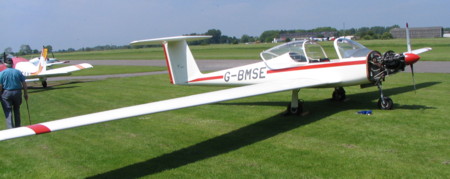 |
Yet another powered glider! The Valentin
Taifun is a more modern design, emerging from Germany in the 1980s.
It is powered by a 90hp Limbach L-2400 engine, which gives it a
cruising speed of 120mph. Range, in theory, is 550 miles, but in
practice it is unlimited as long as it's in glider mode and can find
thermals. Although at a casual glance it looks like a normal powered
aircraft, the 55 foot wing span gives its true nature away. The
undercarriage is retracted by using a hand crank, Bellanca Cruisair
style. It is a two seater and is predominantly made of fibreglass.
This one was at Breighton in June 2007. |





|